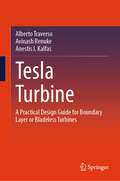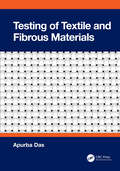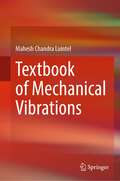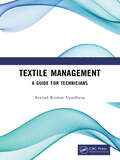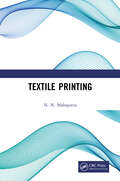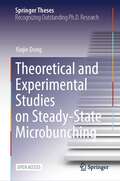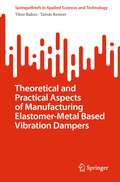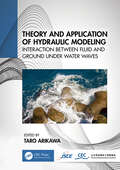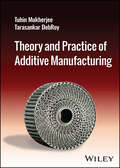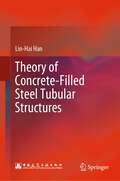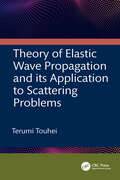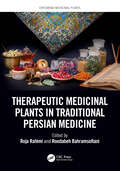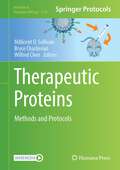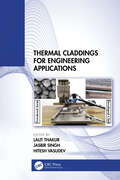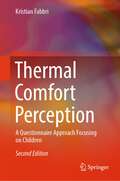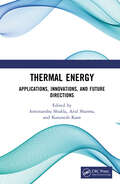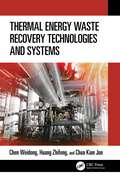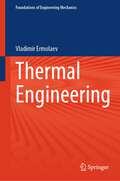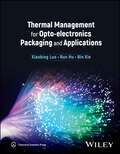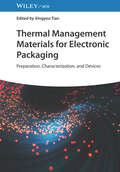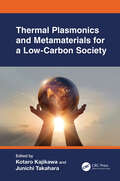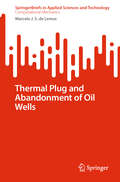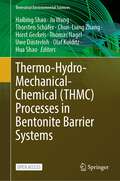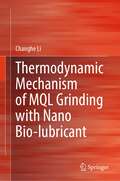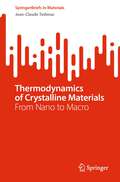- Table View
- List View
Tesla Turbine: A Practical Design Guide for Boundary Layer or Bladeless Turbines
by Alberto Traverso Avinash Renuke Anestis I. KalfasThis book aims at providing the reader with up-to-date knowledge about Tesla turbine features, mechanical design, and performance characteristics. A Tesla machine, in general, is characterised by the absence of rotating blades, therefore it is also called bladeless or boundary layer machine. In this book, suitable numerical approaches for the fluid-dynamic analysis are described, with practical examples related to physical prototypes designed, built and operated by the Authors. Interest in small scale turbines is growing mainly for energy efficiency and power recovery in a variety of applications. Considering small scales, conventional bladed turbines impose manufacturing limitations, lower performance and higher cost, which hinder their implementation. Tesla bladeless turbomachines are being re-discovered due to many advantages such as their simple design and ease of manufacturing with acceptable performance, especially for small-scale power generation and energy harvesting. To contribute to the spread of efficient and viable Tesla turbines (or expanders), this book presents holistic design guidelines to Tesla turbines, encompassing geometrical definition of Tesla rotor, of Tesla stator, of Tesla rotor-stator-casing assembly, providing practical correlations to take into account various loss mechanisms, and discussing the optimal design point definition for such type of century-aged but always young turbines.
Testing of Textile and Fibrous Materials
by Apurba DasThis book contains detailed knowledge about testing principles of fibre, yarn, and fabric characteristics, the tensile characteristics of materials and testing of fibrous-composites and technical textiles. It starts with an introduction to textile testing and further covers moisture in relation to textile materials, sampling techniques for textile materials and the basic applied statistics, fibre characteristics, fibre length, cotton fibre fineness and maturity characteristics. It also deals with the advanced characterisation of cotton fibre by using HVI and AFIS systems.Features: It covers the principles of the testing of textile and fibrous materials along with modern techniques for testing textile materials It reviews all necessary topics related to fibre, yarn, fabric, technical textiles, and composite testing It explores the tensile characteristics of textile materials and measurement principles It discusses low-stress mechanical characteristics and transmission characteristics It includes a large number of examples and exercises based on actual industrial conditions worldwide including solutions This textbook is aimed at senior undergraduate students in textile testing and evaluation of textile materials.
Textbook of Mechanical Vibrations
by Mahesh Chandra LuintelThis textbook covers the fundamentals and applications of mechanical vibrations and is useful for both undergraduate and postgraduate courses. It provides a concise and clear presentation of dynamics and vibrations including many examples to provide instant illustration and applications of the mathematical relations obtained. It contains self-explanatory sketches, graphs, and figures to curtail long text. Numerous illustrated examples, exercises, and problems at the end of each chapter serve as good sources to grasp the basic principles presented in the text. Review questions and sufficient problems have also been included at the end of each chapter with answer keys for self evaluation. This textbook can also be used as a reference book by researchers and professionals interested in vibrations.
Textile Management: A Guide for Technicians
by Arvind Kumar UpadhyayThis book covers the core principles of managing textiles, covering everything from sourcing and production to distribution and sustainability. The objective of this book is to provide relevant information about critical business aspects of the textile industry and its ancillary tools. It covers important concepts of business in a brief and simplified, yet practical way through examples in the form of reports, formats, figures related to respective subjects. Print edition not for sale in South Asia (Bangladesh, Bhutan, India, Nepal, Pakistan and Sri Lanka)
Textile Printing
by N. N. MahapatraTextile printing is the process of applying colour to fabric in definite patterns or designs. This book covers different methods of textile printing like hand block printing, perrotine printing, engraved copperplate printing, roller-cylinder-machine printing, stencil printing, screen printing, digital textile printing, flexo-textile printing, and discharge printing. Print edition not for sale in South Asia (Bangladesh, Bhutan, India, Nepal, Pakistan and Sri Lanka)
Theoretical and Experimental Studies on Steady-State Microbunching (Springer Theses)
by Xiujie DengThis open access book is devoted to the theoretical and experimental studies of a novel accelerator light source mechanism called steady-state microbunching (SSMB) which promises high-power, high-repetition rate, narrow-band coherent radiation in an electron storage ring. The contribution of this dissertation consists of three parts: first, answers the question of how to realize SSMB from a beam dynamics perspective; second, reveals what radiation characteristics can we obtain from the formed SSMB; and third, experimentally demonstrates the working mechanism of SSMB in a real machine for the first time. The highlights of this book can be summarized as: Presents the first proof-of-principle experiment of a promising accelerator light source mechanism; Covers precision longitudinal and transverse-longitudinal coupling dynamics in a storage ring; Provides useful formulas and example parameters for high-power infrared, EUV and soft X-ray light source design.
Theoretical and Practical Aspects of Manufacturing Elastomer-Metal Based Vibration Dampers (SpringerBriefs in Applied Sciences and Technology)
by Tibor Babos Tamás RennerThis book offers a comprehensive breakdown of rubber industry procedures, serving as an invaluable resource for enhancing professional literacy. It covers measurable technological parameters, manufacturing processes, and metallurgy of the materials required for producing high-value rubber-metal machine components. These components find wide applications in the engineering industry, including buffers, vibration damping elements, pipe expansion joints, and silent blocks (vibration dampers vulcanized between steel pipes). The manufacturing of modern machine components necessitates meeting high technical standards and ensuring flawless performance throughout their lifetime. This goal is accomplished by manufacturing components to the required technical parameters with consistent quality specified during the design stage. Unfortunately, scientific descriptions of rubber-metal bonding technologies often lack the detail required for practical application. This book addresses this gap by presenting extensive research conducted by Renner Rubber Products, a key player in the rubber market in Central Europe, drawing on practical experience from the Centre for Security Studies at the Hungarian University of Agriculture and Life Sciences. The book provides a set of technological specifications for rubber-metal bonding based on experiments, measurements, calculations, and proven research results. A noteworthy aspect of the book is that it is the result of close scientific collaboration between academia and industry-leading players, resulting in a highly qualified product applicable in science, academia, and industrial production alike. It serves as a valuable tool for anyone in the engineering industry seeking to enhance their understanding of rubber industry procedures and produce high-quality rubber-metal machine components.
Theory and Application of Hydraulic Modeling: Interaction between Wave and Ground Motion
by Taro ArikawaThis edited volume from Japan’s Research Subcommittee on Methodology for Dealing with Geomaterials in Hydraulic Model Experiments presents readers with a state-of-the-art overview of experimental and computational methods used to address similarity scaling incompatibilities present in fluid–sediment flows.Readers will gain an understanding of complex phenomena in the boundary fields of hydraulics and geotechnical engineering. Chapter contributors focus on the phenomena that are affected by the interactions between fluid wave and ground in a complex field, which for many years have been challenging to process and model. In addition to describing the implementation of model tests and the concept of the law of similarity, this book contrasts these phenomena with the laws of similarity, describes models and numeral analysis methods, and explains important considerations using experimental case studies. Each chapter is written by leading researchers in Japan who are members of the Research Subcommittee on Methodology for Dealing with Geomaterials in Hydraulic Model Experiments. The chapters are closely linked but are written so that each can be read individually. Readers will be able to apply this knowledge to their work and to create models that more accurately simulate the interactions between wave and ground, allowing them to better understand these phenomena and devise more appropriate strategies for defense and so on when necessary.This collection provides information that can be used by young researchers and post-graduate students in the boundary fields of hydraulics and geotechnical engineering who aim at becoming civil engineers, and it will be of particular value to practicing engineers of all experience levels who must regularly analyze complex interactions between fluids and ground.
Theory and Practice of Additive Manufacturing
by Tuhin Mukherjee Tarasankar DebRoyTheory and Practice of Additive Manufacturing Discover the ins and outs of additive manufacturing in this student-friendly textbook Also known as 3D printing, additive manufacturing is a process by which layers of material are added to create three-dimensional objects guided by a digital model. It has revolutionized the design and manufacture of customized products, facilitating the rapid, flexible production of a huge range of goods. It promises to revolutionize manufacturing engineering, shorten industrial supply chains, and more. Theory and Practice of Additive Manufacturing provides the first introduction to this subject designed specifically for students. Balancing the underlying theories behind additive manufacturing with concrete applications, it guides readers through basic processes, essential tools and materials, and more. The result is ideal for readers looking to bring additive manufacturing to bear on engineering or industry careers of almost any kind. Theory and Practice of Additive Manufacturing features: Over 100 worked-out example problems Detailed discussion of the emerging digital tools including mechanistic modeling, machine learning, and more Commitment to pedagogy and reinforcement geared toward student learning outcomes Theory and Practice of Additive Manufacturing is ideal for undergraduate and graduate students and instructors in introductory additive manufacturing courses, as well as practicing engineers and researchers working in industries that use additive manufacturing technologies, including aerospace, automotive, and consumer goods.
Theory of Concrete-Filled Steel Tubular Structures
by Lin-Hai HanThis textbook focuses on concrete-filled steel tubular structures formed by placing concrete inside the steel tube. It deals with the mechanical essence of concrete-filled steel tubular members in compression/tension, bending, torsion, shear and the combined effects, the working mechanism of concrete-filled steel tubular members under long-term load, cyclic load, fire exposure and post-fire exposure, and proposes practical design methods based on experimental and theoretical studies and parametric analysis. The content addresses some key technical issues of concrete-filled steel tubular members, such as the mechanical properties of steel and core concrete, the shrinkage and creep of core concrete, the bonding behavior between steel tube and core concrete, the limiting values for the initial stress of steel tube caused by construction load and the void of core concrete, the protective design of concrete-filled steel tubular members under chloride corrosive environment and impact loading, etc. This textbook also discusses the technology and design principles of concrete-filled steel tubular hybrid structures.
Theory of Elastic Wave Propagation and its Application to Scattering Problems
by Terumi TouheiElastic wave propagation applies to a wide variety of fields, including seismology, non-destructive testing, energy resource exploration, and site characterization. New applications for elastic waves are still being discovered. Theory of Elastic Wave Propagation and its Application to Scattering Problems starts from the standpoint of continuum mechanics, explaining stress and strain tensors in terms of mathematics and physics, and showing the derivation of equations for elastic wave motions, to give readers a stronger foundation. It emphasizes the importance of Green’s function for applications of the elastic wave equation to practical engineering problems and covers elastic wave propagation in a half-space, in addition to the spectral representation of Green’s function. Finally, the MUSIC algorithm is used to address inverse scattering problems. Offers comprehensive coverage of fundamental concepts through to contemporary applications of elastic wave propagation Bridges the gap between theoretical principles and practical engineering solutions The book’s website provides the author’s software for analyzing elastic wave propagations, along with detailed answers to the problems presented, to suit graduate students across engineering and applied mathematics.
Therapeutic Medicinal Plants in Traditional Persian Medicine (Exploring Medicinal Plants)
by Roja Rahimi Roodabeh BahramsoltaniTraditional Persian Medicine (TPM) is one of the oldest medical doctrines, globally known due to pioneering physicians and scientists. The greatest source of natural medicines in TPM originates from medicinal plants. Therapeutic Medicinal Plants in Traditional Persian Medicine provides a background on the history of TPM, as well as an introduction to 40 of the most popular medicinal plants used in TPM. It is a practical guide for readers interested in medicinal plants used in the prevention, management, and treatment of different diseases.Features: Includes both traditional therapeutic applications and modern evidence/ uses Makes a comparison between preclinical and clinical studies Provides information on major chemical constituents, therapeutic uses, adverse reactions, and safety for each plant species A volume in the “Exploring Medicinal Plants” series, this book is a valuable resource for researchers, students, academicians, and scientists dealing witth medicinal plants, as well as for those interested in the fields of pharmacognosy, naturopathy, phytotherapy, and traditional medicines.
Therapeutic Proteins: Methods and Protocols (Methods in Molecular Biology #2720)
by Millicent O. Sullivan Bryce Chackerian Wilfred ChenThis volume covers the latest key aspects of therapeutic protein applications. Chapters in this book cover topics such as the discovery, production, and conjugation of protein-proteins with discussions on the direction of future development and advancements; ways to use these engineering proteins for therapeutic and vaccine applications; and the use of modified protein nanocarriers. Written in the highly successful Methods in Molecular Biology series format, chapters include introductions to their respective topics, lists of the necessary materials and reagents, step-by-step, readily reproducible laboratory protocols, and tips on troubleshooting and avoiding known pitfalls.Cutting-edge and practical, Therapeutic Proteins: Methods and Protocols is a valuable resource for any researcher who are interested in learning more about the field of therapeutic proteins.
Thermal Claddings for Engineering Applications
by Jasbir Singh Lalit Thakur Hitesh VasudevThe text presents advances in the field of thermal claddings for protection against erosion, corrosion, and wear in hydraulic turbines, automobiles, agricultural equipment, power plant, chemical industries, and jet engines. It further discusses different cladding techniques such as electron beam, oxyfuel, arc welding processes, and microwave hybrid heating. It explains the mechanism for failure of materials and cladding and emphasizes the protection mechanism.This book: Discusses the design and simulation of thermal claddings and the use of algorithms to predict the process parameters and performance of developed clads using artificial intelligence and machine learning Presents the tribological behaviour of novel wear-resistant thermal claddings for the components used in construction, mining, drilling, and hydropower plant Showcases high-temperature oxidation, corrosion, and erosion-resistant thermal claddings for power plants, the automotive sector, and jet engines Highlights the application of the thermal cladding process in remelting the existing surface to enhance the surface properties Examines post-heat treatment procedures on thermal claddings for improving the microstructure and tribological properties The text is primarily written for senior undergraduate, graduate students, and academic researchers in the fields of mechanical engineering, manufacturing engineering, industrial engineering, and production engineering.
Thermal Comfort Perception: A Questionnaire Approach Focusing on Children (Springerbriefs In Applied Sciences And Technology Ser.)
by Kristian FabbriThis book offers a comprehensive exploration of children's understanding and experiences of thermal comfort. The book provides a methodology for evaluating comfort that takes into account the unique perspectives of children. The first part of the book provides an overview of the history of thermal comfort, the human body and environmental parameters, and common thermal comfort indexes. It also offers guidelines for creating questionnaires that accurately assess children's perceptions of indoor thermal comfort. The book then delves into children's understanding of the concepts of comfort and energy, as well as the factors that influence their perception of these concepts. It addresses the psychological and pedagogical aspects of thermal comfort judgment, as well as the architectural and environmental characteristics that contribute to children's perceptions of comfort. First published as Indoor Thermal Comfort Perception, this updated edition also includes new sections on architecture and sensitivity, exploring the impact of classroom spaces on learning, and outdoor education and thermal comfort outdoors, based on qualitative research. These additions provide valuable insights for future studies on these topics. While physical parameter measurements and comfort indexes are useful in thermal comfort, the book emphasizes the importance of ergonomic assessments in the form of questionnaires, which offer unique insights into children's experiences. The book fills a critical gap in understanding children's perceptions of thermal comfort and is essential reading for HVAC engineers, architects, environmental psychologists, and researchers in the medical and cognitive fields.
Thermal Energy: Applications, Innovations, and Future Directions
by Amritanshu Shukla Atul Sharma Karunesh KantThis book presents the essentials of thermal energy storage techniques along with recent innovations and covers in-depth knowledge of thermal energy applications. Different aspects of thermal energy storage systems are covered, ranging from fundamentals to case studies. Major topics covered include application of thermal energy in water heating, solar cooking and solar pond, thermal energy storage materials for indoor comfort in buildings, thermal management of battery, hydrogen production, reducing carbon footprints, and so forth. Key features: Presents current research and technological updates along with applications and market scenarios in thermal energy storage, thermal management, and applications of thermal energy Explores sensible, latent, and thermochemical energy storage aspects Emphasizes the need and adequate utilization of abundant heat energy for clean energy perspectives Reviews use of thermal energy in hydrogen production, the oil and gas sector, along with market analysis Includes pertinent case studies This book is aimed at researchers and graduate students in energy and mechanical engineering, energy storage, and renewables.
Thermal Energy Waste Recovery Technologies and Systems
by Weidong Chen Zhifeng Huang Kian Jon ChuaThermal Energy Waste Recovery Technologies and Systems comprehensively covers thermal energy recovery technologies and systems. It considers thermal sources, working principles, products, application status, prospects, and challenges. In an effort to achieve energy security, carbon neutralization, and sustainable development, this book discusses waste recovery from thermal energy technologies and systems from varying temperatures. This book features case studies of advanced multi-generation systems for different industrial applications. This book is intended for senior undergraduate and graduate mechanical engineering students taking courses in thermal energy, energy systems, and renewable energy, as well as researchers studying thermal energy utilization, low-carbon technologies, thermal dynamic analysis, and energy system design.
Thermal Engineering (Foundations of Engineering Mechanics)
by Vladimir ErmolaevThis book presents the fundamental principles of thermodynamics and heat transfer, providing a solid foundation for understanding energy systems. From the core concepts of basic thermodynamic state parameters and ideal gases to the complexities of real gases and vapors, this book provides the knowledge to analyze and manipulate energy in various engineering applications. It covers topics such as heat capacity, thermodynamic processes, and the First Law of Thermodynamics, giving insights into how energy is harnessed and utilized. The book explores advanced subjects like second law thermodynamics, circular cycles, and the thermodynamic analysis of thermal power cycle installations, unveiling the intricacies of energy efficiency. The second section of the book shifts focus to heat transfer mechanisms, covering thermal conductivity, convective heat transfer, and thermal radiation. The book is useful to anyone interested in the complexities of energy dynamics in engineering systems.
Thermal Management for Opto-electronics Packaging and Applications
by Xiaobing Luo Bin Xie Run HuThermal Management for Opto-electronics Packaging and Applications A systematic guide to the theory, applications, and design of thermal management for LED packaging In Thermal Management for Opto-electronics Packaging and Applications, a team of distinguished engineers and researchers deliver an authoritative discussion of the fundamental theory and practical design required for LED product development. Readers will get a solid grounding in thermal management strategies and find up-to-date coverage of heat transfer fundamentals, thermal modeling, and thermal simulation and design. The authors explain cooling technologies and testing techniques that will help the reader evaluate device performance and accelerate the design and manufacturing cycle. In this all-inclusive guide to LED package thermal management, the book provides the latest advances in thermal engineering design and opto-electronic devices and systems. The book also includes: A thorough introduction to thermal conduction and solutions, including discussions of thermal resistance and high thermal conductivity materials Comprehensive explorations of thermal radiation and solutions, including angular- and spectra-regulation radiative cooling Practical discussions of thermally enhanced thermal interfacial materials (TIMs) Complete treatments of hybrid thermal management in downhole devices Perfect for engineers, researchers, and industry professionals in the fields of LED packaging and heat transfer, Thermal Management for Opto-electronics Packaging and Applications will also benefit advanced students focusing on the design of LED product design.
Thermal Management Materials for Electronic Packaging: Preparation, Characterization, and Devices
by Xingyou TianThermal Management Materials for Electronic Packaging Practical resource exploring the theoretical and experimental basis as well as solutions for the development of new thermal management materials for electronic packaging Thermal Management Materials for Electronic Packaging: Preparation, Characterization, and Devices provides in-depth and systematic summaries on cutting-edge thermal management materials for high-power density electronic devices, introducing the preparation methods and application scenarios of thermal management materials for electronic packing, covering refinements of thermal conductivity theory and performance prediction models for multiphase composites, and overall focusing on key scientific issues related to the subject, such as the internal interface of new high thermal conductive substrate materials and the mechanism of spatial topology on performance. The text also discusses key issues on the design and preparation of thermal conductive substrate materials with high thermal conductive properties, including their characterization, properties, and manipulation, as well as the latest methods, techniques, and applications in this rapidly developing area. Sample topics covered in Thermal Management Materials for Electronic Packaging include: Basic concepts and laws of thermal conduction, heat conduction differential equation and finite solution, and thermal conductivity of solids Definition and classification of electronic packaging, thermal management in electronic equipment, and requirements of electronic packaging materials Synthesis and surface modification of high thermal conductive filler and the synthesis of substrates and preparation of thermal conductive composites with inorganic ceramic skeleton structure Assembly of thermal conductive materials in different dimensions and preparation of composite materials, and reliability analysis and environmental performance evaluation Thermal Management Materials for Electronic Packaging serves as an ideal reference for researchers and workers in related fields to significantly improve the mechanical and thermal management properties of materials, expand the material selection and design margin of substrates, and develop substrates that meet the application needs of different gradients.
Thermal Plasmonics and Metamaterials for a Low-Carbon Society
by Kotaro Kajikawa Junichi TakaharaIn this edited volume for researchers and students, experts in thermal plasmonics and metamaterials technologies introduce cutting-edge energy and resource conservation techniques and environmentally friendly solutions in areas including energy generation and harvesting and radiative cooling.Through this book, readers will gain an in-depth understanding of the metamaterials and thermal plasmonics technologies used for such devices and the real-world applications of these technologies. This book is divided into three broad sections to address different aspects of these devices. The first section presents research on materials that can control thermal radiation and optical absorption, phase transition materials, and optical design using AI; the second covers research on thermophovoltaic elements, energy harvesting, and radiative cooling; and the third introduces research on photothermal materials’ applications, such as solar steam generation, desalination, recyclable inks, and radiative textiles. Each chapter is authored by an expert whose research is focused on a specific related technology or application. Readers can apply the information in this book to address many common problems related to environment and energy conservation.This book is invaluable for researchers and graduate students working in the fields of nanophotonics, energy, and environmentally friendly solutions, whether they are working on advancing the underlying technologies or expanding the range of usable applications to solve common global problems related to energy use, cooling, and resource consumption.
Thermal Plug and Abandonment of Oil Wells (SpringerBriefs in Applied Sciences and Technology)
by Marcelo J.S. de LemosThis book evaluates a new potential game-change technology where burning a compound known as “thermite” is used to melt the casing, cement and rock forming an impermeable plug within the wellbore. A review on current and emerging technologies is presented. The development of analytical, numerical and experimental tools is documented in separate sections of the book, showing results and discussing the potential for this new technology and its role on the ongoing energy transition process worldwide.
Thermo-Hydro-Mechanical-Chemical (Terrestrial Environmental Sciences)
by Thomas Nagel Olaf Kolditz Hua Shao Haibing Shao Ju Wang Thorsten Schäfer Chun-Liang Zhang Horst Geckeis Uwe DüsterlohThis book is open access book. The collaborative Pilot Project, titled “Comparison of Thermo-Hydro-Mechanical-Chemical (THMC) Processes in Bentonite Barrier Systems”, aims to investigate the fundamentals, conduct laboratory and field experiments, and develop numerical models for barrier systems that ensure the safe isolation of radioactive waste in deep geological repositories. This book compares methodologies and technologies used in experimental laboratory and field research, as well as systems analysis, in a collaborative work of German and Chinese scientists. Both parties have access to exceptional experimental and modelling research capabilities. The Beishan underground research laboratory (URL) is currently under construction in Gansu, China. It will serve as an international collaboration platform for URL research in the future. International cooperation is essential for excellent research and development due to the high cost of scientific programmes and technical operation of URLs, making it a precondition for providing secure solutions. This is important not only for deep geological repositories for radioactive waste disposal but also for other geoenergy applications, such as energy storage and geothermal energy utilization.
Thermodynamic Mechanism of MQL Grinding with Nano Bio-lubricant
by Changhe LiThis book discusses the thermodynamic mechanism of MQL grinding with nano-biological lubricant from the force, heat, surface integrity, and micro-morphology.It makes up the fatal defect of the lack of heat transfer capability of traditional MQL grinding. The machining accuracy, surface quality, especially surface integrity of the workpiece, are significantly improved; at the same time, the service life of the grinding wheel is increased and the working environment is improved.The general scope of the book’s content is the effects of MQL grinding with nano-bio-lubricant on grinding force, thermal mechanism, and surface.It provides a new method of sustainable green grinding for environment-friendly, resource-saving, and energy-efficient utilization and solves the technical bottleneck of the insufficient capacity in MQL heat transfer.
Thermodynamics of Crystalline Materials: From Nano to Macro (SpringerBriefs in Materials)
by Jean-Claude TedenacThis book provides expert treatment of the use of the Calphad calculations for the study of crystal structures and thermodynamics relationships in phase diagram determination. After a short review of the relationships between crystal structures and the thermodynamics of materials, including all possible phase transformations, the book proceeds to a brief discussion of the methods for solving the stability hierarchy of different phases. Coverage includes both theoretical calculations and experimental methods based on classical thermodynamics, with emphasis on the latter. The experimental approach is mainly carried out using heat-exchange data associated with the transition of one form into another. It is demonstrated that the crystallographic properties must be associated with the phase transformations and should be taken into account. The role of X-ray crystallography therein is also discussed. Readers interested in carrying out related research will appreciate the detailed discussion and critical analysis of key results obtained by the author and his colleagues over the past five years.
